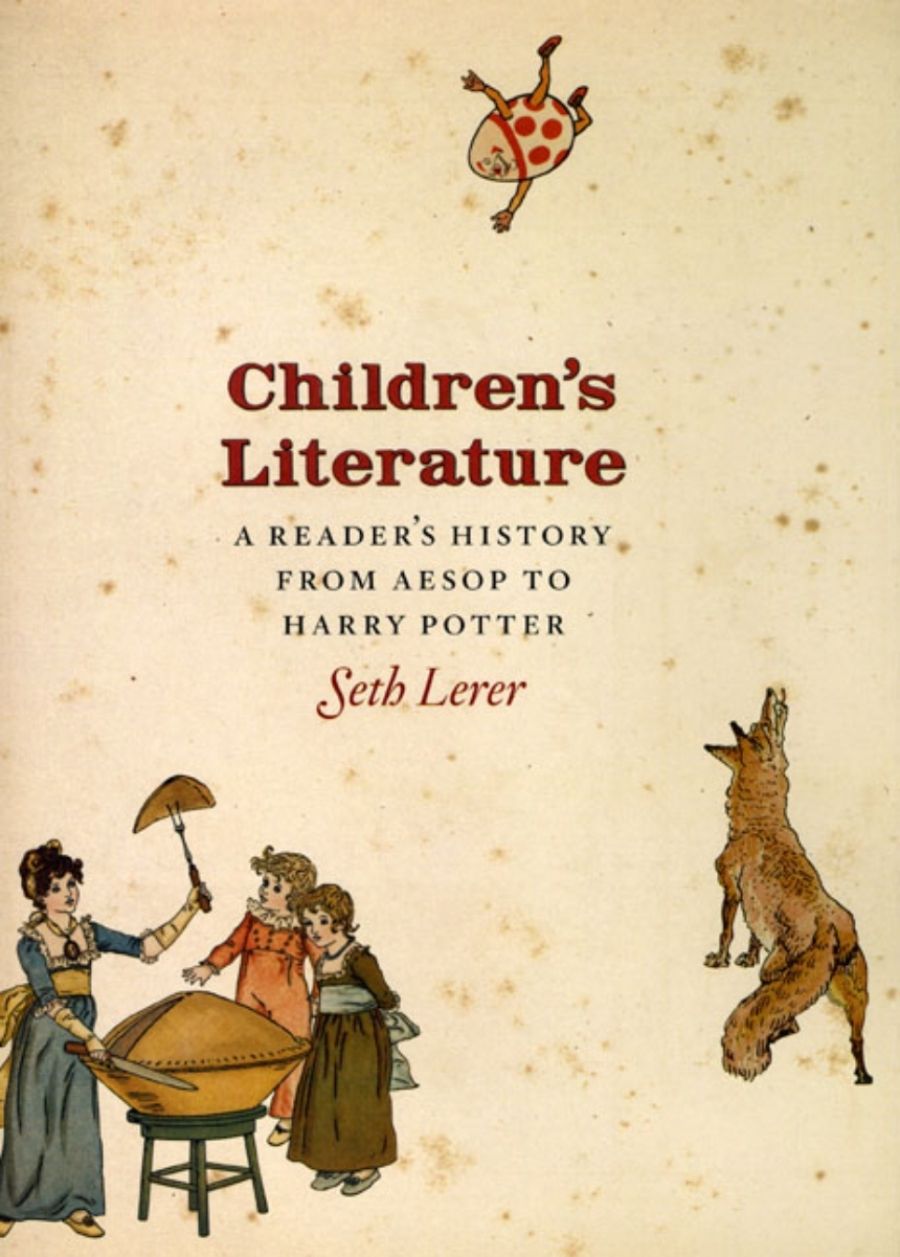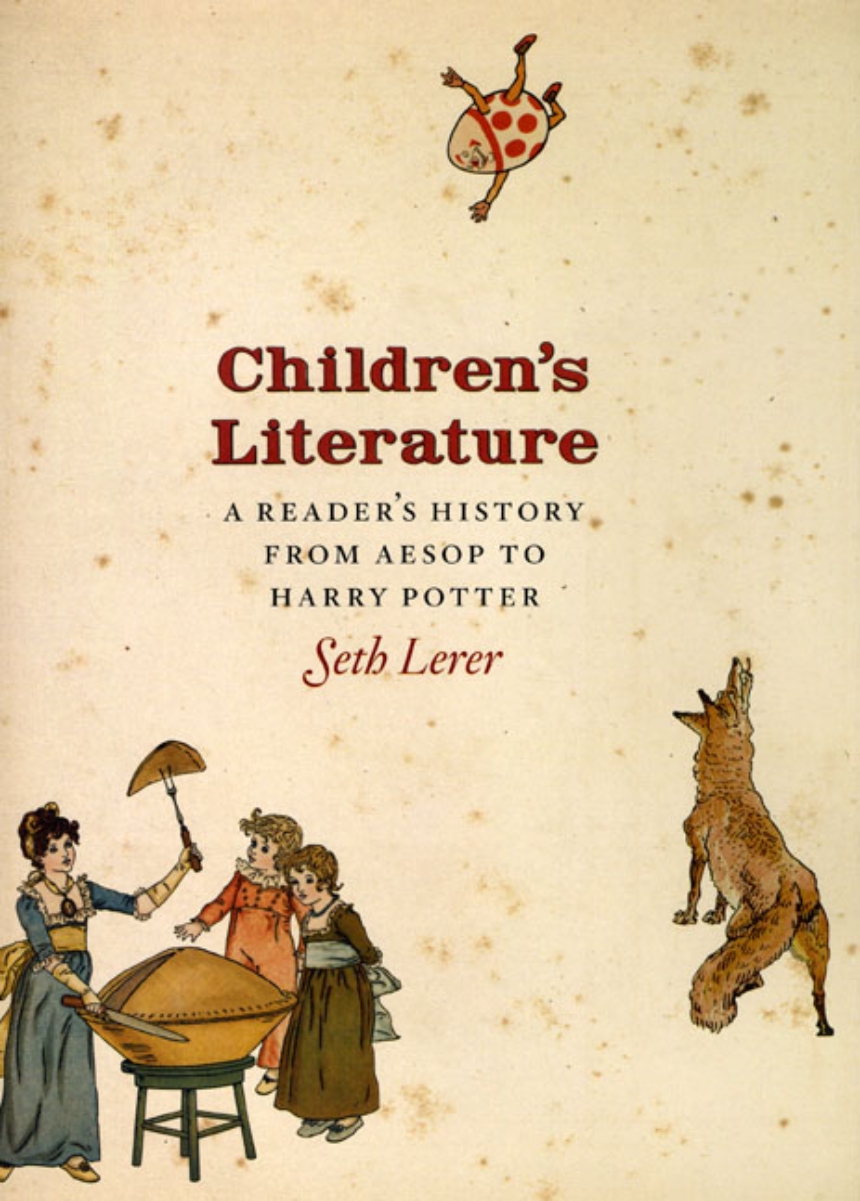
- Free Article: No
- Contents Category: Literary Studies
- Review Article: Yes
- Article Title: From papyrus to Harry Potter
- Online Only: No
- Custom Highlight Text:
‘Dress me and put my shoes on; it is time, it is the hour before dawn, so that we should get ready for school.’ This colloquy, probably from Gaul in the third or fourth century, prescribes the ideal child’s conversation, from waking and greeting his parents politely to walking home, with his slave, from school at noon.
Seth Lerer’s history of children’s literature starts with papyrus and ends with Harry Potter. It is called a ‘reader’s history’ because Lerer does not only look at literature written for children – a comparatively recent phenomenon. He also looks at what children actually read: abecedaria, excerpts from Virgil and Homer, versions of Aesop, lists and plays, folktales, prayers and psalters, boy scout manuals, magazines, and chapbook versions of Robinson Crusoe.
- Book 1 Title: Children’s Literature
- Book 1 Subtitle: A reader’s history, from Aesop to Harry Potter
- Book 1 Biblio: University of Chicago Press (Footprint Books), $45.95 hb, 394 pp
- Book 1 Cover Small (400 x 600):

- Book 1 Cover (800 x 1200):

Of course, any history of what children read is a history of childhood. Lerer shows an intriguing range of approaches, over time, to educating and entertaining children. He also suggests how these relate to a society’s conception of human nature, its past, and its future – for it seems, whatever the approach, we always treat children as the material of our inheritance and ambition.
‘The Greeks may have loved their children, but the Romans celebrated them. Indeed, they came up with the birthday party …’ The real strength of this book is the way it combines this grand historical tour with anecdotal and emblematic detail. In this way, it keeps making us think of a child reading; for a scholarly work, it is oddly moving and often surprising. Take Lerer’s account of Aesop’s fables. Lerer shows how they changed in translation over two and a half thousand years. Phaedrus, for instance, translated them not only into Latin but also into the Latin world, giving them a modish setting, an elegant verse form and a socially polished sort of wit. In his version of the fable of King Demetrius and the poet Menander, Menander sashays in at last to pay his respects. ‘Who is that little queer [cinaedus]?’ sneers the king. ‘That is Menander, the writer [scriptor].’ The king, immediately changing his tune, replies, ‘No man could appear more fair’.
Lerer also shows how Christian translators made the fables accord with their own traditions: treating the animals as aspects of human character, and the fables as moral exempla. One of Aesop’s fables tells how a murderer met his death:
A man who had committed murder was being pursued … When he came to the river Nile and encountered a wolf, in his fright he climbed a tree … There he saw a snake opening its jaws at him and flung himself into the river. A crocodile in the river caught him and ate him.
Christian translations from the fifth century recast this fable as a story of patricide, and placed it in a moral landscape:
A son who had killed his own father … took refuge in a desolate place, but … he was pursued by a lion … [and] mounted a tree. But he saw a serpent lying on it and, unable to climb further, he was killed. The evil man never escapes from God, for the divine leads evil people to justice.
Lerer shows how the Christian faith gave a particular resonance to family stories and changed the natural world into an allegorical place. Here, the lion typifies secular justice and the serpent sin. Even the landscape is moral.
Lerer’s argument is interesting, but his next point suggests what is really distinctive about this book. He takes another fable: ‘A fox, after looking … at a tragic actor’s mask [persona tragica], remarked, “O what a face is here, but it has no brains!” In Walter of England’s version, a wolf comes not upon a mask, but a disembodied head: “O cheeks without a voice, O head without a mind.” This version adds a gloss: “O head with great beauty and ornamentation, your cheeks proud, but without a voice. Your head made up with rouge and hair curled, as if to say, beauty is a lie.”’ Lerer links this version with the moment when Hamlet comes upon Yorick’s disinterred skull:
Here hung those lips that I have kissed I know not how oft. Where be your gibes now? … Quite chapfall’n? Now get you to my lady’s chamber, and tell her, let her paint an inch thick, to this favor, she must come …
The gloss to the fable might suggest why Hamlet turns this reflection on death to a point about vanity. If the fables – schoolroom texts of the time – constitute the background of this scene, then it works as an encounter with lost youth, as well as with death. These are the points – often personal, speculative, arguable, intriguing – that enliven this study and give it range.
Lerer’s account of medieval children’s literature is similarly digressive and often funny. For instance, he recounts the scatological wit in the medieval play Mankind. Without realising it, he identifies perhaps the earliest use of the Australian catch-cry oi oi oi: ‘Compare, for example, the Play of Daniel’s use of the French legal call “O hez!” [Hear ye] with the character Nowaday’s parody of the same idiom: oy-yt, oy-yit, oyet!’ In fact, this character, Nowaday, demonstrates a prescient grasp of modern idiom: ‘Osculare fundamentum,’ he says (Kiss my arse).
Lerer’s study of the Puritan movement shows a different kind of range. Again, he combines large claims with telling details. He argues that the Puritans started children’s literature as a distinct genre. ‘Puritanism was a movement for the future,’ he writes, and argues that this dependence on the future occasioned a new literature, designed to inculcate moral virtues in the child.
Here, as elsewhere in this work, Lerer emphasises cultural and philosophical reasons for change. Other writers may have placed more emphasis on the advent of the printing press and, in England, on the rise of a new, urban middle class. Though he discusses such things, Lerer treats them as the means of change, not the cause. Fair enough. His discussion is distinguished by a poetic apprehension of Puritan books, an account of them in terms of lists and elegies. For, if the Puritans found a new, jewel-like quality of innocence in children, they did their best to darken it. Lerer shows how often their children’s books focus on death. In the New England Primer, for instance, the verses that follow the Ten Commandments run: ‘I in the Burying Place may see / Graves shorter there than I; / From Death’s Arrest no Age is free, / Young Children too may die.’
Chapter by chapter, Lerer chooses a theme that draws together a wide range of examples. For instance, he connects Locke’s theory of education, and empirical philosophy, with a change in children’s literature, from allegory to crowded realism. He links Darwin’s theory of evolution to nonsense literature from Lewis Carroll to Dr Seuss. He describes the Edwardian cult of youth. In all such cases, the details give his arguments point and interest. For instance, he notes that ‘Diagon Alley’ in Harry Potter is a translation of ‘Queer Street’.
Lerer is the Avalon Professor of Humanities at Stanford University. A philologist by training, his interest in the history of words probably explains the amount of pleasant detail in this book. Lerer’s last book, Inventing English: A Portable History of the Language (2007), gained a wide readership. He has also written on Boethius, Chaucer, Anglo-Saxon and medieval literature. This book brings together a lifetime’s academic work. It carries the burden of an academic style – a sort of buttonholing insistence – more lightly than you might expect, partly because it keeps different registers of voice: teacher, lecturer, speaker, editor, parent.
Only when it comes to contemporary children’s literature does Lerer’s book lose range and sharpness. His selection of books seems ad hoc and his discussion entirely personal. For instance, he hardly mentions Roald Dahl, and ignores Enid Blyton. He also leaves out works that have been on school set lists for decades: The Catcher in the Rye (1951), for instance, and To Kill a Mockingbird (1960). In fact, he hardly reflects upon whether school set lists have changed how children read. Beyond Harry Potter, he also gives no account of fantasy after Tolkien and Lewis – no Ursula le Guin or Philip Pullman, though fantasy is what many children nowadays read for pleasure.
Sins of omission are not venial, in literature at least. But any one of these examples might usefully have challenged Lerer’s claims about ‘books for boys’ and ‘books for girls’.
These are, I think, boys’ books, and they may represent, as well, a response to the ironies of stories such as those I have reviewed here. For what is clear … is that the gifted masters of ironic detachment are girls … [but] bullshit remains very much a boy’s game.
What could it mean to characterise style in this frankly sexist way? Does the ironic detachment in Augusten Burrough’s Running with Scissors (2002) make it a woman’s book? Does the swagger in Lionel Shriver’s The Female of the Species (1986) make it a book for men? If we would not accept such categorisation of adult literature, outside Mills & Boon, why should we accept it of literature for children? The current trade in bum-joke books for boys and chicklet-lit for girls needs analysis, not reiteration, here.
This is, for the most part, a wide-ranging, rich, intriguing and intelligent work. Only the books published in Lerer’s lifetime get short shrift.


Comments powered by CComment